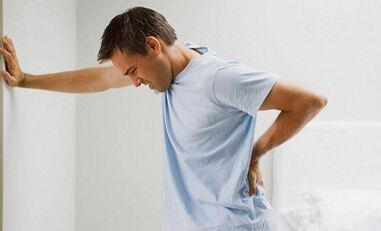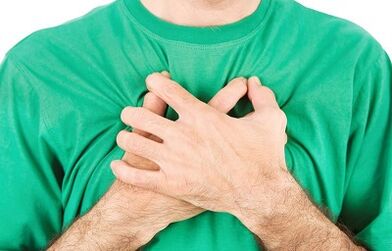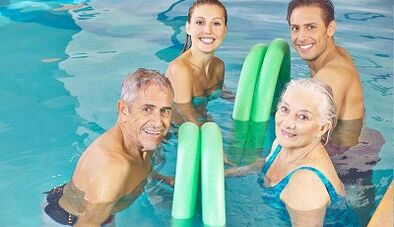
Lumbar osteochondrosis is a chronic damage to the lumbar spine that develops in the intervertebral discs as a result of many years of physical impacts and metabolic disorders.It is proven that lumbar osteochondrosis is the cause of back pain in 75% of cases.
Lumbar spine loss occurs in 60% of the inhabitants of the planet - this is the most common manifestation of osteochondrosis.The first signs of the disease appear in 20-30 years.
The risk of the disease is that in the later stages of the disease (when they appear (extension) and hernia of the intervertebral discs), complications that require surgical intervention, in particular, planar fascia and a pile stimulation.
Lumbar osteochondrosis often complicates pregnancy.
Causes of lumbar osteochondrosis
The main cause of the disease is the systemic load on the lumbar spine and the metabolic disorders of the fibrous layer of the intervertebral discs.Lifting weights, excess weight, constant physical work increase pressure on the vertebral column.
Other causes of lumbar osteochondrosis: sitting and sedentary living, constant wearing high heels, malnutrition, consumption of small liquids, smoking, alcohol abuse.
When muscle protective frames and lack of treatment, blood supply to the tissues worsens and degenerative processes in the intervertebral discs deteriorate.As a result, the intervertebral discs do not get enough supply in the blood - they lose elasticity, "dry", inflamed, flattened and prolonged.
When lengthening (extension), the spinal nerve is violated, which is manifested by pain at rest and during movements.Incorrect posture and damage provoke an uneven addition to the spinal column, which accelerates the development of lumbar osteochondrosis.
Stages of lumbar osteochondrosis
The particularity of the disease is the gradual development of degenerative processes.
Neurologists distinguish 4 stages of lumbar osteochondrosis:
- First stage& Mbsp;Partial inflammation and flattening of intervertebral discs.It manifests by burning at the lower back and thick not severe pain in the lower back.Unpleasant sensations arise after physical exercise, weight lifting.
- The second phase- The distance between the vertebrae is reduced, changes in the fibrous ring around the tissue are determined in the radiograph, and the extension of the disks.The patient feels a sharp pain in the lower back, which gives (radiates) the buttocks and legs.
- Stage 3- the appearance of intervertebral hernia due to the destruction of the fibrous ring of the vertebrae.In the 3rd stage, the cartilage and beads are destroyed intensely.Pain gains constant character, they also feel at rest.
- Stage 4- Atrophy of the cartilage and intervertebral discs, accompanied by the pathological growth of the bone tissue of the vertebrae and the formation of osteophytes.The pain appears with every movement and any unpleasant position of the body.The pain does not go on its own.These violations require intense treatment and leads to severe human disability.
Symptoms of lumbar osteochondrosis

In seventy percent of cases, doctors diagnose the disease in the second phase.During this period, the patient observes frequent periods of irritation with bright symptoms:
- Low pain, which is improved by physical exercise.As degenerative processes develop, the pain becomes severe and constant;
- Limiting movements.Movements are associated with increased pain with radiation in the buttocks and feet;
- change of sensitivity to lower extremities (tingling, burning, numbness);
- spinal muscle tension;
- Numbness and coldness of the legs.
Diagnosis of lumbar osteochondrosis
In 85% of cases, doctors make a diagnosis using radiographs, calculated tomography and magnet resonance imaging (MRI) images.
The most intended method is MRI.With its help, doctors determine the site and degree of spinal cord damage.
The main task of the specialist is to distinguish osteochondrosis from Bekhterev's disease.
Complications of lumbar osteochondrosis
Lumbar radiculitis, or Roying Syndrome: The pathological process in the spinal nerve is the most common complication of lumbar osteochondrosis.Occurs in 55% of cases.It is associated with damaged pain and sensitivity to the lower back and/or along the violated root.
In the later stages of the disease, a flattened intervertebral disc that comes out of the edge of the vertebra - the extension.When the fibrous ring is destroyed, an intervertebral hernia is formed.Intervertebral hernia is an occasion to contact a neurosurgeon.
In 40% of patients, the sciatica is inflamed.This provokes pain, numbness of the limbs.As a result, the patient tolerates body weight on a healthy leg;The back is even more curved, which exacerbates the severity of the disease.

10% of patients develop a narrowing of the spinal canal, or compression myelopathy - by squeezing the spinal cord.Requires surgical treatment.
The rarer but dangerous complication is the "horse tail" syndrome - the loss of some nearby nerve roots.
Patiento the third patient with this complication has paresis or palsy.It also requires surgical treatment.
Treatment of lumbar osteochondrosis
It is impossible to cure lumbar osteochondrosis.You can remove the pain and slow down the degenerative processes in the beads and discs.80% of success in treatment falls in stages 1 and 2 of the disease.
If there are no complications, neurologists treat lumbar department osteochondrosis with medicines, physiotherapy exercises, massage and physiotherapy.
Medications are prescribed for osteochondrosis irritation to eliminate inflammation, pain and stimulation of metabolism in vertebrae, cartilage, discs.
In acute pain, the therapeutic effect is achieved by intramuscular administration of medication.For local anesthesia, preverstebral blockages have been described.For 3-6 months, patients are prescribed chondroprotectors.
The purpose of physiotherapy exercises is to strengthen the back muscles of the back.Pool exercises are very useful.With lumbar osteochondrosis, exercises are performed after eliminating pain.Some doctors prescribe physiotherapy exercises even with pain, however, this should be carefully approached.
After the pain deduction, massage and reflexology courses are recommended.
Complex lumbar osteochondrosis requires no frequent hospital treatment and many days.The disease is treated at home.They turn to folk remedies whose action descends to heat the lower back.
Prevention of lumbar osteochondrosis
To prevent lumbar osteochondrosis, adhere to simple rules:
- Follow the behavior during many hours of stay in a sedentary position, change the position of the body;
- swim 3 times a week;
- Raise the severity with two hands from a sitting position or, adjusting (adjusting) your back;
- Avoid designs;
- For a night's rest, choose an orthopedic mattress.


















